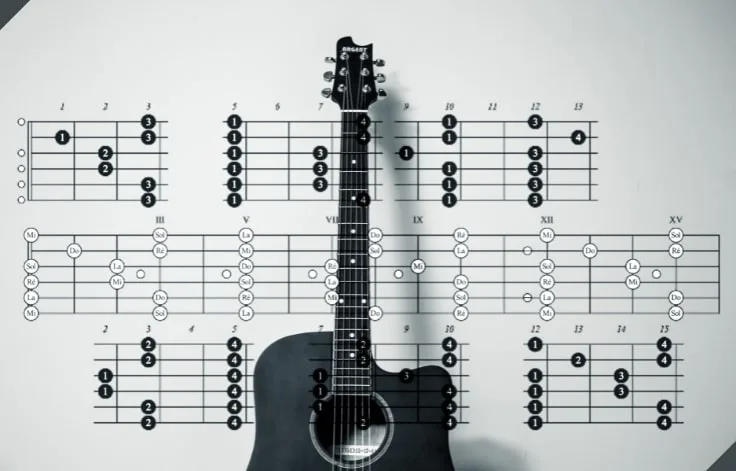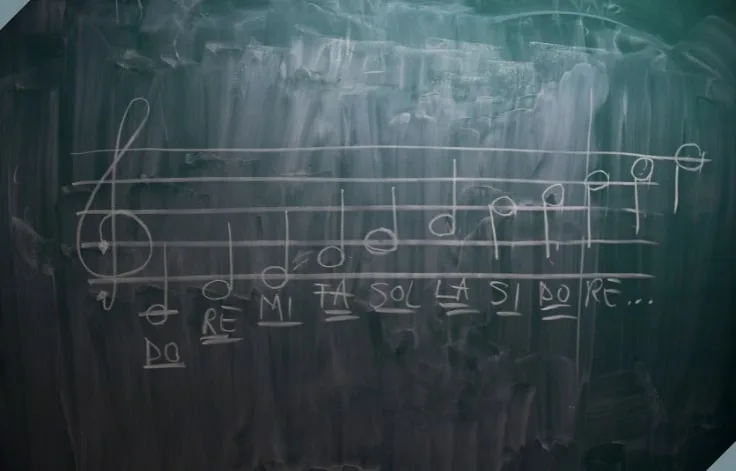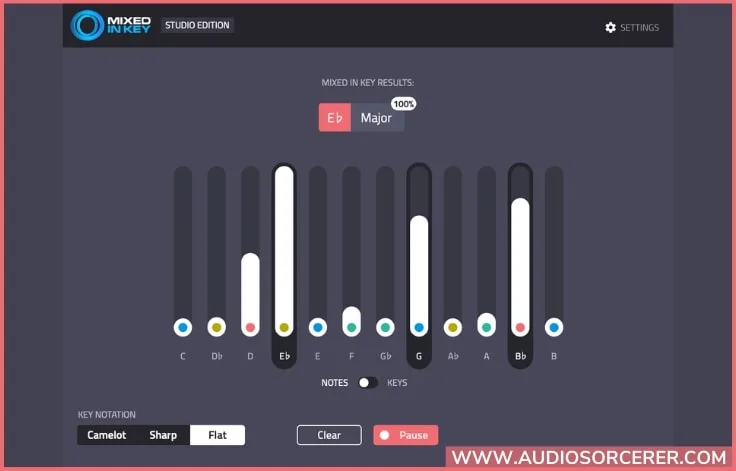
One of every musician’s worst nightmares is not knowing what key to play in. No one wants to be the person at a jam session who has to ask, Uhm…what key are we in? Knowing how to identify the key of a song and the notes that go along with it separates the amateurs, who are running around like headless chickens, and the advanced players.
When you start talking about a song’s key, you’re knocking on the door that leads to a place many aspiring musicians run away from: music theory. But fear not, lads and lasses! There are no monsters behind that door. Finding the key of a song and remembering what notes go along with it is nothing to be afraid of.
In this article, we’re going to dive into 5 simple ways to find what key a song is in. By the end, you’ll be a key finding master!

What Is A Key In Music?
A key in music tells you which notes and chords make up a song. Think of it like the guidelines or parameters that musicians get to work with when writing music. Each key is made up of 7 notes, and you can use those notes in any way you would like – well, there are a few rules to this, but let’s save that for another time.
For example, the key of C uses the notes C, D, E, F, G, A, and B. So, if you are jamming with your buddies and someone says, let’s play the C Major Key with a 1-4-5 progression. You’ll know to play the first, fourth, and fifth chords in the key of C (C, F, and G) – easy!
Switching and experimenting with different keys will give you a lot of freedom. People who like to play an instrument and sing along will be able to find the key that best matches their singing voice – La, La, Laaaaaahhhh (glass shatters).
How Many Keys Are There In Music?
In music, there are 12 major and 12 minor keys, adding up to 24 in total. But wait! Three of both the major and minor keys can actually be spelled in two different ways, giving us a total of 30. I know that sounds a little confusing, but using the circle of fifths as a reference can help clear things up.
The C major and G major are two of the most common keys used in songwriting, and – hallelujah! – they are also two of the most straightforward scales to memorize. However, don’t let the fear of flats and sharps scare you away from learning some of the more complex keys – remember, there are no monsters behind the door!
How To Find What Key A Song Is In?
Below we are going to go over 5 simple methods to find what key a song is in. These methods range from music theory to using your ear to using software. Lets first look at using the key signature of a song.
Method 1 – Key Signature
If you are using sheet music and want to know what key a song is in, move your eyes to the beginning of the measure – it’s hiding in plain sight! Just after the treble or clef symbol, you’ll see a single or group of sharps and flats that will tell what key the song is in – this is known as the key signature. But how will you know the key?
Each key has a unique number of sharps or flats, so when the sheet music gives you 2 sharp symbols, you can identify the key of D, which contains two sharps – and two sharps only. Let’s look at these charts to make things easier.
| Sharp(s) | Key |
| 0 | C |
| 1 | D |
| 2 | G |
| 3 | A |
| 4 | E |
| 5 | B |
| 6 | F |
| Flat(s) | Key |
|---|---|
| 0 | C |
| 1 | F |
| 2 | B |
| 3 | E |
| 4 | A |
| 5 | D |
| 6 | G |
If you can’t remember how many sharps or flats are in a key, there is another handy trick: when looking at sheet music that uses flats, write them out in order – left to right. The second to last flat will be the key of the song. Additionally, suppose you have sheet music displaying sharps. In that case, the key will be represented as the note a half-step up from the last sharp.
Try making flashcards to memorize the number of sharps and flats associated with each key. You’ll have them down in no time!
Method 2 – Look At The Chords In The Song

Looking at the chords of a song is a great and easy method to identify what key a song is in. Simply write down all the chords used and start checking them off from each key – kind of like Music Theory Bingo.
As we established earlier, a key has seven chords; to be more specific, it has 3 major chords, 3 minor chords, and one diminished chord. The key would be easy to identify if a song used all seven chords. However, that’s rarely the case. Most of the time, you’ll only have 3 to 5 chords to crack the code. You won’t be able to check off all the chords in the key, but it’s rarely necessary to have more than 3 chords to uncover the key being used.
For example:
The key of F contains the chords F Major, G Minor, A Minor, Bb Major, C Major, D Minor, and E diminished.
If you have a song that uses the chords F Major, C Major, D Minor, and Bb Major, you could look at a chart of chords and figure out that the song’s key is in F.
Keep in mind that the rules of music aren’t set in stone. A song may include a chord that is outside of the key, but that’s okay! The key hasn’t changed, and there’s no need to panic.
Method 3 – Match The Notes To A Scale

If you are analyzing a song primarily made up of notes, you can compare them with the different scales to find the key. Unlike using chords, we won’t be able to identify notes as major or minor, but it makes the process a little more straightforward.
Write down all the notes used in the song and match them up with the seven possible notes in each key. Eventually, a clear pattern will become visible, and you can pick out the song’s key.
The more notes you have available, the more accurate you’ll be. Sometimes keys can appear to overlap if you don’t have notes to work with, but it will still help whittle down the options.
Going through the scales and crossing out each note might feel tedious in the beginning. With a little practice, you’ll start to memorize which note belongs to which key and become wicked fast.
Method 4 – Use Mixed In Key Studio Edition

What about DJs and music producers? When you don’t have access to the notes or chords of a song, you’ll have to rely on your ear, but there’s another option – a far easier option. That’s where the Studio Edition of Mixed In Key comes into play.
Mixed In Key Studio Edition is a program that you can purchase and download on your computer. It will identify the key of any sound or music you play. You will have the option to view the key in its Sharp, Flat, or Camelot notation. For people who are looking for the right sample to match the key of a song, Mixed In Key has got you covered. It’s a great tool to speed up your workflow and improve your music!
To add the cherry on top, Mixed In Key Studio Edition only costs $58 for an instant download. For anyone making electronic music, it’s a no-brainer.
Method 5 – Getsongkey.com
For those who aren’t looking to spend money but still want to run a song through a digital key finder, Getsongkey.com is a great option. On the website, you can upload your audio file, and the application will give you the key of the song. The website claims the free key finder has an accuracy of 70-95% -not too shabby! Head over to the site to give it a shot.
How Common Is A Song Key Change?
Sometimes songwriters will throw their listeners for a loop and change keys mid-song. Key changes aren’t necessarily rare, but you won’t hear them in a majority of music. Chances are you can think of at least one song with a key change because, when it happens, it’s memorable.
The point of a key change is to alter the energy of a song. For example, a musician could add a key change at the end of a piece to finish with a big, exciting outro. They can also be used to take listeners on a journey. When one key ends and the other begins, it feels like entering new territory because, well, you are! Whether musicians decide to bring the key – and listeners – back to where it all began is up to them and a part of the musical experience.
Final Thoughts
At first glance, identifying what key a song is in can look like a tall order to fill. However, you’ll see it’s not so intimidating when you break the process down – note by note. Remember, if you are using sheet music, locate the key signature and count the number of flat or sharp symbols provided. Take the notes and chords of a song and match them with those in each key. If all else fails, use one of the convenient online key finders like the Mixed In Key Studio Edition or Getsongkey.com. Good luck!
“Some of the links within this article are affiliate links. These links are from various companies such as Amazon. This means if you click on any of these links and purchase the item or service, I will receive an affiliate commission. This is at no cost to you and the money gets invested back into Audio Sorcerer LLC.”



